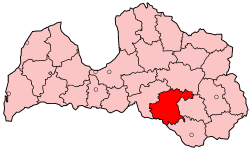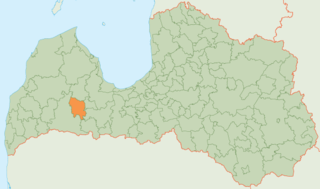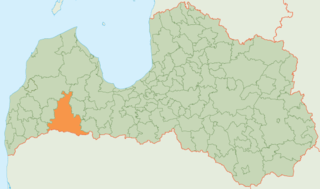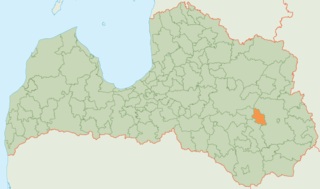
Jēkabpils district was an administrative division of Latvia, located in Latgale region, in the country's east. It was organized into three cities and twenty one parishes, each with a local government authority. The main city in the district was Jēkabpils.

Riga district was an administrative division of Latvia, located in Semigallia and Vidzeme regions, in the centre of the country. It was the de facto successor of the historical Riga county since 1949.

Kuldīga district was an administrative division of Latvia, located in Courland region, in the country's west. It was organized into a city and thirteen parishes, each with a local government authority. The main city in the district was Kuldīga.

Brocēni is a town in Saldus Municipality in the Courland region of Latvia. The town is situated along the river Ciecere, near lake Cieceres, which contains a large deposit of limestone that is used in the manufacturing of cement. From 2009 to 2021, the town was the center of Brocēni Municipality.

Bauska district was an administrative division of Latvia, located in Semigallia region, in the country's centre. It was organized into a city, a municipality and fifteen parishes, each with a local government authority. The principal city was Bauska.

Jelgava district was an administrative division of Latvia, located in Semigallia region, in the country's centre. It was organized into a city, two municipalities and twelve parishes, each with a local government authority. The administrative centre of the district was Jelgava. It preceded and used the symbols of the Jelgavas apriņķis of the interwar Republic of Latvia, which was created in 1920 from the previous Dobeles apriņķis.

On 1 July 2009 the 26 districts of Latvia, introduced in 1949 by the Soviet occupation authorities to supersede counties, were divided into 77 cities, 10 amalgamated municipalities, 24 rural territories and 475 parishes.
Saldus is a Latvian town located in Courland region of Latvia, and the largest town in Saldus Municipality. The name Saldus has been noted in historical sources as far back as the mid-13th century, but the founding year for the establishment of the town is considered to be 1856, with the settlement gaining town rights in 1917.

Ogre Municipality is a municipality in Vidzeme, Latvia. The municipality was formed in 2002 by merging Ogre town and Ogresgals Parish. In 2009 it absorbed Krape Parish, Ķeipene Parish, Laubere Parish, Madliena Parish, Mazozoli Parish, Meņģele Parish, Suntaži Parish and Taurupe Parish, the administrative centre being Ogre. The population in 2021 was 57,617.

Brocēni Municipality was a municipality in Courland, Latvia. As of 2020, the population was 5,633.

Lutriņi Parish is an administrative unit of Saldus Municipality, Latvia.

Zvārde Parish is an administrative unit in the Eastern part of Saldus Municipality, Latvia. It borders with the Novadnieki, Kursīši, Ruba and Jaunauce parishes, Brocēni Municipality Ciecere and Blīdene parishes and Auce Municipality Lielauces and Vītiņu parishes.

Jēkabpils Municipality is a municipality in Latvia. The municipality was formed in 2009 by merging Ābeļi Parish, Dignāja Parish, Dunava Parish, Kalna Parish, Leimaņi Parish, Rubene Parish and Zasa Parish. During the 2021 Latvian administrative reform, the previous Jēkabpils Municipality was merged with Aknīste Municipality, Krustpils Municipality, Sala Municipality and Viesīte Municipality. The new municipality now fully corresponds with the area of the pre-2009 Jēkabpils District.

Kuldīga Municipality is a municipality in Courland, Latvia. The municipality was formed in 2009 by merging Ēdole parish, Gudenieki parish, Īvande parish, Kabile parish, Kurmāle parish, Laidi parish, Padure parish, Pelči parish, Renda parish, Rumba parish, Snēpele parish, Turlava parish, Vārme parish and Kuldīga town. The administrative centre is Kuldīga. As of 2020, the population was 22,028.

The former Saldus Municipality was a municipality in Courland, Latvia. The municipality was formed in 2009 by merging parts of the former Saldus District: Saldus town, Ezere Parish, Jaunauce Parish, Jaunlutriņi Parish, Kursīši Parish, Lutriņi Parish, Nīgrande Parish, Novadnieki Parish, Pampāļi Parish, Ruba Parish, Saldus Parish, Šķēde Parish, Vadakste Parish, Zaņa Parish, Zirņi Parish and Zvārde Parish.

Skrunda Municipality was a municipality in Courland, Latvia. The municipality was formed in 2009 by merging Skrunda town with its countryside territory, Raņķi parish, Nīkrāce parish and Rudbārži parish; the administrative centre being Skrunda. The population in 2020 was 4,543.

Viļāni Municipality is a former municipality in Latgale, Latvia. The municipality was formed in 2009 by merging Dekšāres Parish, Sokolki Parish, Viļāni Parish and Viļāni town; the administrative centre being Viļāni. The population as of 2020 was 5,417.

Ciecere Parish is an administrative unit of Saldus Municipality, Latvia. It was created in 2010 from the countryside territory of Brocēni town. At the beginning of 2014, the population of the parish was 1028.

Saldus Municipality is a municipality in Courland, Latvia. The municipality was formed in 2021 by merging the former Saldus Municipality and Brocēni Municipality. Its centre is the town of Saldus.

Blīdene is a village in Blīdene Parish, Saldus Municipality in the Courland region of Latvia. It is the parish center. The village has formed on the Blīdene river shores and A9 highway.



















